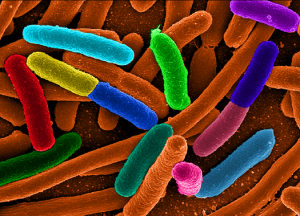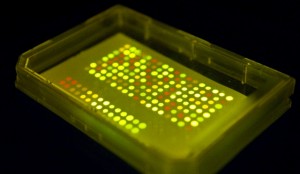Texting via Bacteria?
Sending messages has gotten rather boring these days. Pony Express? Yeah right. E-mail? So 20th century. Text messages? Played out. When the Defense Advanced Research Projects Agency (DARPA) sent out a challenge to devise a new form of message encryption, a team of scientists at Tufts University stepped up to the plate.
The technique has become known as SPAM (Steganography by Printed Arrays of Microbes). Scientists genetically altered strains of E. Coli bacteria to emit one of seven different colors when exposed to a particular chemical. These strains of bacteria are encoded and arranged in pairs onto a thin surface with a toothpick. The Tufts scientists arranged the bacteria in a dot system that can be observed and translated under a microscope. The system is slow because it doesn’t use any modern technology and the messages need to be created by hand.
Some of the benefits of the new technology are that they’re very flexible; there are the 7 different colors that are arranged in pairs to create 49 separate characters including numbers and .+-@#=?$ symbols. The system also features secure message protection methods; the bacteria can be modified to lose it’s color after a certain amount of time. It doesn’t seem to be ideal for colorblind individuals, however, as there is not a whole lot of variation in the tomato, cherry, orange, yellow, green, and cyan colorgrid.
If you’re sick of the traditional forms of communication, just round up your toothpick, genetically modified bacteria, and microscope and you’ll be sending trendy 21st century messages in no time.
Comments
Tags: 21st century communication, bascteria messages, DARPA, Defense Advanced Research Projects Agency, e coli, spy message, Steganography, Steganography by Printed Arrays of Microbes, texting via bacteria
Trackback from your site.



Comments (2)
Maven
| #
Someone logged too much time with their “litebrite”, and the disappearing ink pen and the morse code decoder ring from their Spy kit.
Reply
Dennis Krieger
| #
fascinating! this is the stuff of the future
Reply